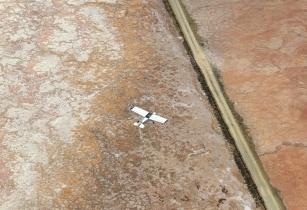How new technology and innovative approaches with Seequent are revolutionising the search for freshwater – above and below ground
Water security is a topic that has increasingly concerned academia, government and NGOs in recent years – with good cause. Climate change, burgeoning populations, increasing supply costs, and shifting lifestyles have all placed pressure on this critical resource.
This is especially true in Africa. In 2018, Cape Town narrowly averted “day zero” – a day the city was expected to run dry – and similar events are occurring around the world. Seequent sees water security inextricably linked to society’s continued growth and prosperity.
Efficiently managing groundwater resources has taken a step change forward compared to just a few years ago. The combination of modern airborne geophysics, the recycling of pre-existing geophysics (e.g. from oil and gas exploration) and new technology solutions means that a far better overview and management of potential groundwater sources can be achieved at lower costs, and more quickly.
The airborne hunt for clues
Drilling is challenging. It can be difficult, slow, expensive and comes with many environmental concerns. That is why the practice of using geophysics and remote sensing to rapidly cover a survey area has considerable appeal, and its adoption has been growing significantly in recent years.
Electromagnetic (EM) surveys can be done from the air, to cover large areas (of 50 or 100 sq km) with absolutely no ground access required, as well as give a fast turnaround on 3D models of the subsurface, meaning better-informed decisions, more quickly.
Seequent solutions provide the capability for cutting edge inversion of airborne EM surveys, straightforward implementation in hydrogeological modelling software and a way to define saltwater intrusion problems
Helping Somalia towards water security
In Somalia, less than 45 per cent of the population has access to safe drinking water. At the same time, the country has been the focus of various oil and gas exploration campaigns. Shifting from oil to water is a relatively small step. Seequent customer Ruden AS is making the shift happen with the innovative Search Model solution.
Chief financial officer and project manager Helene Ruden said, “We are applying the Search Model approach to a project in Somalia supported by the Norwegian Ministry of Foreign Affairs, to assess the deep groundwater potential on a national scale. Seequent’s Leapfrog is helping combine all sorts of data to create an overview of the subsurface. Its versatility greatly increases the ability to combine different datasets in a reliable, precise and convenient way.”
Getting the data to give up its answers
Seequent provides tools that support team efforts for building, maintaining, and communicating the hydrogeological models to help identify where water and good well locations are. However, these models only tell part of the story and do not allow for the management of the aquifer system over time. For that, a groundwater model is needed. Leapfrog software can easily translate a hydrogeological model into a Modflow model and visualise the results. This gives a reliable analysis of the sustainable yield and an enhanced tool for defining well placement and recharge area protection.
Since groundwater conditions change all the time, it is important that updating water table analyses, adding wells, revising water quality maps and more, are all straightforward. The implicit modelling at the heart of Leapfrog is designed specifically for easy analysis and maintenance. Seequent Central helps keep track of these changes so they can be confidently shared with – and easily understood by – stakeholders, who are increasingly demanding clearer and more transparent explanations around this essential resource.





















